Leukemia Therapeutics Market Research, 2031
The global leukemia therapeutics market size was valued at $7,818.63 million in 2021 and is estimated to reach $14,162.48 million by 2031, exhibiting a CAGR of 6.1% from 2022 to 2031.Leukemia is a type of blood cancer that results in abnormal cell growth of leukocytes. It is classified as either acute or chronic leukemia. It occurs most often in adults, and older than 55. Due to deficiency in healthy blood cells, several symptoms develop such as bleeding, brushing, bone pain, fatigue, and fever. In addition, depending on patients’ needs, the treatment includes combination of chemotherapy, targeted therapy, and immunotherapy.
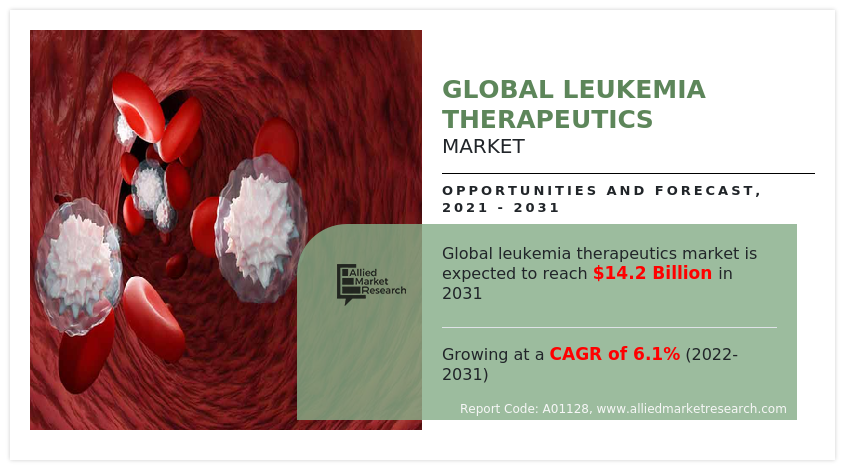
Market Dynamics
Leukemia remains a major health concern and there is a growing need for more effective treatment that can improve the patients' outcomes. This has driven the development of new therapies such as tyrosine kinase inhibitors (TKIs) that target specific genes or proteins involved in growth and spread of leukemia cells. In addition, there has been a growing awareness about leukemia and need for effective treatments, led to growing demand for leukemia therapeutics such as chemotherapy and targeted therapy drugs. Furthermore, the rise in healthcare expenditure globally is driving the growth of the leukemia therapeutics market. The growing focus on personalized medicine and the development of new diagnostic tools have led to a rise in demand for targeted treatments.
Moreover, the high unmet medical need for more effective treatment for leukemia has led to an increase in investment in R&D, fueling the growth of the market. In addition, rise in technological advancements such as development in targeted and immunotherapies have led to growing demand for effective treatment for leukemia driving the growth of the market. Growing demand for combination therapies that can provide more comprehensive approaches to treatment. This has driven the development of new combination therapies such as chemotherapy and immunotherapy. These drivers are contributing to the growth of the leukemia therapeutics market share.
However, the continued development of new and more effective treatments for leukemia such as immunotherapy and targeted therapy is expected to provide lucrative leukemia therapeutics market opportunity for market growth. Rise in product approvals for leukemia therapeutics by various key players is set to affect the market growth positively. For instance, in October 2020, Gilead Sciences, Inc. announced the U.S. Food and Drug Administration (FDA) has granted approval for Tecartus (brexucabtagene autoleucel) for the treatment of adult patients (18 years and older) with relapsed or refractory B-cell precursor acute lymphoblastic leukemia (ALL).
The leukemia therapeutics market growth is expected to be driven by high potential in untapped, emerging markets, due to availability of improved healthcare infrastructure, increase in unmet healthcare needs, rise in prevalence of chronic lymphocytic leukemia, and surge in demand for leukemia therapeutics. Furthermore, the healthcare industry in emerging economies is developing at a significant rate, owing to rise in demand for enhanced healthcare services, significant investments by government to improve healthcare infrastructure, and development of the medical tourism industry in emerging countries. The demand for leukemia therapeutics is not only limited to developed countries but is also being witnessed in the developing countries, such as China, Brazil, and India, which fuel the growth of the market. Factors such as rise in adoption of targeted therapy and increase in awareness toward early diagnosis and treatment for leukemia further drive the growth of the market.
In contrast, many of the treatments available for leukemia can be quite expensive, which limits their accessibility to patients. In addition, introduction of generic drugs into the market reduces the prices of treatments and limit the growth of the leukemia therapeutics market. Furthermore, development and marketing of new treatments for leukemia require a rigorous regulatory environment which can be time consuming and expensive. This limits the speed of new treatment development and regulatory approvals, which in turn hinders market growth.
The COVID-19 pandemic caused disruptions in the supply chain for treatment of leukemia which affects the availability of leukemia therapeutics to patients. In addition, COVID-19 pandemic has disrupted the clinical trials process for many new treatments for leukemia causing delays and potentially affecting the development of new treatment which led to negatively impact the market growth. Moreover, delay in initiation of treatment for leukemia due to disruptions to healthcare systems restrains market growth. Moreover, companies and research organizations reduced their investment in R&D in response to the economic impact of the COVID-19, which limits the development of new treatment for leukemia. However, the market is anticipated to witness recovery in 2021, owing to growing awareness of the need for improved treatment for leukemia is expected to drive the leukemia therapeutics market forecast.
Segmental Overview
The leukemia therapeutics market is segmented into type, drug class, distribution channel and region. By type, the market is categorized into acute lymphocytic leukemia, acute myeloid leukemia, chronic lymphocytic leukemia, chronic myeloid leukemia, and others. By drug class, the market is segregated into chemotherapy, and targeted & immunotherapy. By distribution channel, the market is classified into hospital pharmacies, drug stores & retail pharmacies, and online providers. Region wise, the market is analyzed across North America, Europe, Asia-Pacific, and LAMEA.
By Type
The market is segmented into acute lymphocytic leukemia, acute myeloid leukemia, chronic lymphocytic leukemia, chronic myeloid leukemia, and others. The chronic lymphocytic leukemia segment dominated the global market in 2021 and is expected to remain dominant throughout the forecast period, owing to rise in product approvals for chronic lymphocytic leukemia and availability of leukemia therapeutics for chronic lymphocytic leukemia.
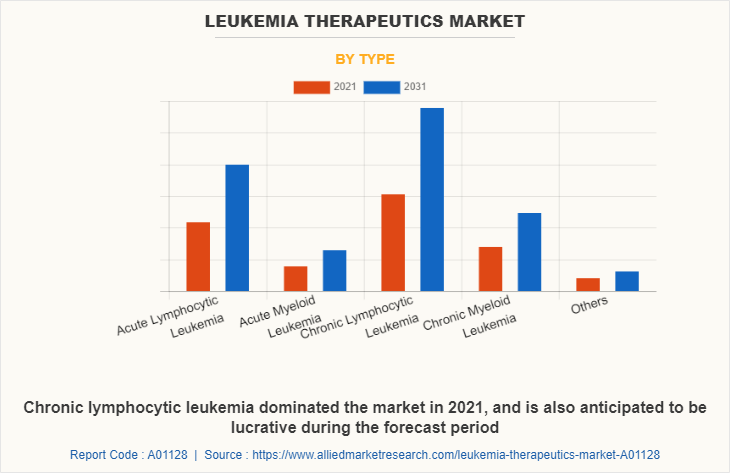
By Drug Class
The leukemia therapeutics market is segregated into chemotherapy, and targeted & immunotherapy. The targeted & immunotherapy segment dominated the global market in 2021 and is anticipated to continue this trend during the forecast period. This is attributed to an increase in adoption of targeted & immunotherapy due to fewer side effects.
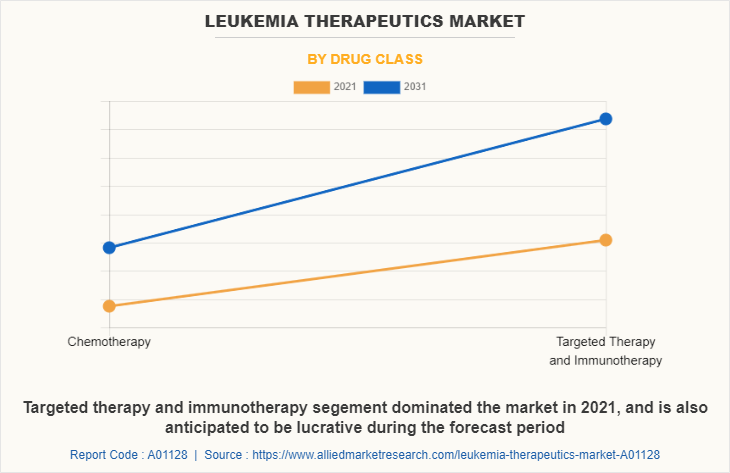
By Distribution Channel
The market is classified into hospital pharmacies, drug stores & retail pharmacies, and online providers. The hospital pharmacies segment held the largest market share in 2021 and is expected to remain dominant throughout the forecast period. Rise in public awareness about leukemia and its treatment options has led to more people seeking treatment in hospitals, thereby driving the growth of the hospital pharmacies segment. However, the online providers segment exhibited the highest CAGR during the forecast period, owing to continuous services, and availability of a wide range of options. Furthermore, increase in e-commerce sales, improvements in logistics services, and ease in payment options propel growth of the market.
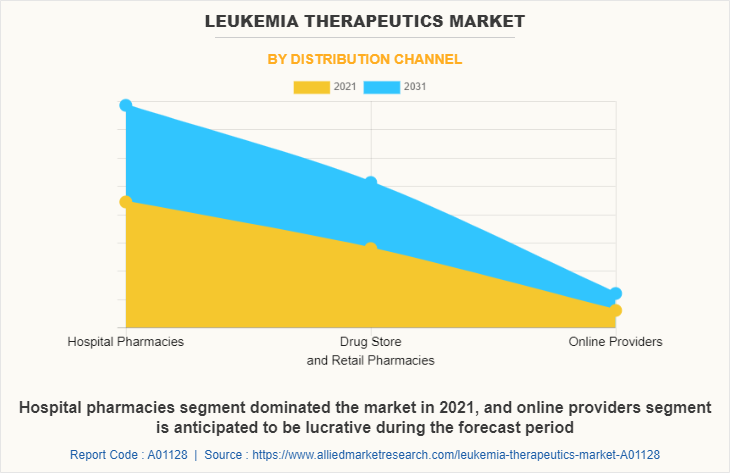
By Region
The leukemia therapeutics market size is analyzed across North America, Europe, Asia-Pacific, and LAMEA. North America accounted for a major share of the leukemia therapeutics market in 2021 and is expected to maintain its dominance during the forecast period.
The presence of several major players, such as Novartis AG, Pfizer Inc., Bristol-Myers Squibb Company, AbbVie Inc., and others and advancement in manufacturing of leukemia therapeutics in the region drive the growth of the market. Furthermore, presence of well-established healthcare infrastructure, high purchasing power, and rise in adoption rate of targeted therapy drugs for leukemia are expected to drive the market growth. Furthermore, product launch and product approvals adopted by the key players in this region boost the growth of the leukemia therapeutics industry.
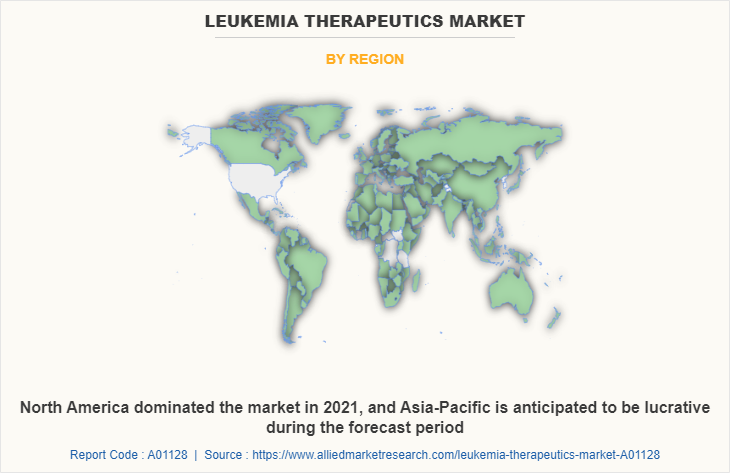
Asia-Pacific is expected to grow at the highest rate during the forecast period. The market growth in this region is attributable to presence of pharmaceutical companies in the region as well as growth in the purchasing power of populated countries, such as China and India. Moreover, rise in personalized medicine expenditure and adoption of high-tech processing to improve the production of leukemia therapeutics drive the growth of the market. Furthermore, the Asia-Pacific region exhibits the largest medicine supply and the largest pharmaceuticals industry with availability of raw material in abundance, which can be easily accessed by manufacturers of leukemia therapeutics. This, in turn, drives the growth of the leukemia therapeutics industry.
Asia-Pacific offers profitable opportunities for key players operating in the leukemia therapeutics market, thereby registering the fastest growth rate during the forecast period, owing to the growing infrastructure of industries, rise in disposable incomes, as well as well-established presence of domestic companies in the region. In addition, the rise in contract manufacturing organizations within the region provides great opportunity for new entrants in this region.
Competition Analysis
Competitive analysis and profiles of the major players in the leukemia therapeutics market share, such as AbbVie Inc. Amgen Inc., Bristol-Myers Squibb Company, Gilead Sciences, Inc., Lupin, Novartis AG, Pfizer Inc., Sanofi, Takeda Pharmaceutical Company Limited, and Teva Pharmaceutical Industries Limited. Major players have adopted product approvals as key developmental strategies to improve the product portfolio of the leukemia therapeutics market.
Recent Product Approvals in the Leukemia Therapeutics Market
- In December 2020, Takeda Pharmaceutical Company Limited announced that the U.S. Food and Drug Administration (FDA) has approved the supplemental New Drug Application (sNDA) for ICLUSIG (ponatinib) for adult patients with chronic-phase (CP) chronic myeloid leukemia (CML).
- In June 2020, Pfizer Inc. announced that the European Commission approved DAURISMO (glasdegib) in combination with low dose cytarabine (LDAC), a type of chemotherapy, used for the treatment of newly diagnosed acute myeloid leukemia (AML) in adult patients who are not candidates for standard chemotherapy.
- In June 2021, Bristol Myers Squibb announced that the European Commission (EC) has granted full marketing authorization for Onureg (azacitidine tablets) as a maintenance therapy in adult patients with acute myeloid leukemia (AML).
- In September 2020, Bristol Myers Squibb Company announced the U.S. Food and Drug Administration approved the Onureg (azacitidine tablets), a new oral therapy, as continuation therapy for adults with acute myeloid leukemia in first remission.
- In December 2020, Amgen Inc. announced that the U.S. Food and Drug Administration (FDA) has approved RIABNI (rituximab-arrx), a biosimilar to Rituxan (rituximab), for the treatment of adult patients with Non-Hodgkin's Lymphoma (NHL), Chronic Lymphocytic Leukemia (CLL), Granulomatosis with Polyangiitis (GPA) (Wegener's Granulomatosis), and Microscopic Polyangiitis (MPA).
- In October 2020, AbbVie announced the U.S. Food and Drug Administration (FDA) has provided full approval for VENCLEXTA (venetoclax) in combination with azacitidine, or decitabine, or low dose cytarabine (LDAC) for the treatment of newly diagnosed acute myeloid leukemia (AML) in adults.
- In October 2020, Gilead Sciences, Inc. announced the U.S. Food and Drug Administration (FDA) has granted approval for Tecartus (brexucabtagene autoleucel) for the treatment of adult patients (18 years and older) with relapsed or refractory B-cell precursor acute lymphoblastic leukemia (ALL).
Key Benefits For Stakeholders
- This report provides a quantitative analysis of the market segments, current trends, estimations, and dynamics of the global leukemia therapeutics market analysis from 2021 to 2031 to identify the prevailing global leukemia therapeutics market opportunities.
- The market research is offered along with information related to key drivers, restraints, and opportunities.
- Porter's five forces analysis highlights the potency of buyers and suppliers to enable stakeholders make profit-oriented business decisions and strengthen their supplier-buyer network.
- In-depth analysis of the global leukemia therapeutics market segmentation assists to determine the prevailing market opportunities.
- Major countries in each region are mapped according to their revenue contribution to the global market.
- Market player positioning facilitates benchmarking and provides a clear understanding of the present position of the market players.
- The report includes the analysis of the regional as well as global leukemia therapeutics market trends, key players, market segments, application areas, and market growth strategies.
Leukemia Therapeutics Market Report Highlights
| Aspects | Details |
| Market Size By 2031 | USD 14.2 billion |
| Growth Rate | CAGR of 6.1% |
| Forecast period | 2021 - 2031 |
| Report Pages | 392 |
| By Type |
|
| By Drug Class |
|
| By Distribution channel |
|
| By Region |
|
| Key Market Players | Pfizer Inc., Novartis AG, Takeda Pharmaceutical Company Limited, Lupin, Gilead Sciences, Inc., Bristol-Myers Squibb Company, Abbvie Inc, Teva Pharmaceutical Industries Limited, Sanofi, Amgen Inc. |
Analyst Review
This section provides various opinions of top-level CXOs in the global leukemia therapeutics market. According to the insights of CXOs, the global leukemia therapeutics market is expected to exhibit high growth potential attributable to rise in incidences of leukemia and surge in awareness toward early diagnosis and treatment. However, side effects of leukemia therapeutics such as fatigue, hair loss, anemia, low blood cell count, and infection hamper the market growth.
CXOs further added that the rise in number of product approvals for leukemia therapeutics drives the market growth. For instance, in December 2020, Takeda Pharmaceutical Company Limited announced that the U.S. Food and Drug Administration (FDA) has approved the supplemental New Drug Application (sNDA) for ICLUSIG (ponatinib) for adult patients with chronic myeloid leukemia (CML).?
Furthermore, North America is expected to witness highest growth, in terms of revenue, owing to rise in incidences of leukemia, the presence of key players for manufacturing & developing of leukemia drug such as chemotherapy and targeted therapy drugs and surge in number of hospitals for the treatment in the region. However, Asia-Pacific is anticipated to witness notable growth, owing to rise in prevalence of leukemia and increase in investments for manufacturing leukemia therapeutics during the forecast period.
Rise in incidences of leukemia, increase in investment in the R&D activities for leukemia and rise in awareness of the targeted therapies among the population are the factors responsible for the market growth.
The chronic lymphocytic leukemia segment is the most influencing segment owing to rise in incidences of chronic lymphocytic leukemia.
North America is the largest regional market for leukemia therapeutics.
Top companies such as Pfizer Inc., Novartis AG, Bristol-Myers Squibb Company, and AbbVie Inc. held high market share in 2021.
The leukemia therapeutics market valued for $7,818.63 million in 2021 and is estimated to reach $14,162.48 million by 2031, exhibiting a CAGR of 6.1% from 2022 to 2031.
2021 is the base year of leukemia therapeutics market.
2022-2031 is the forecast year of leukemia therapeutics market.
Loading Table Of Content...



